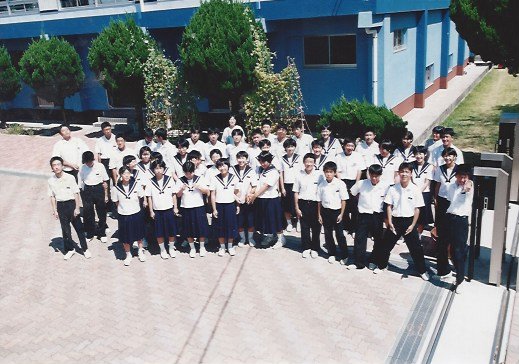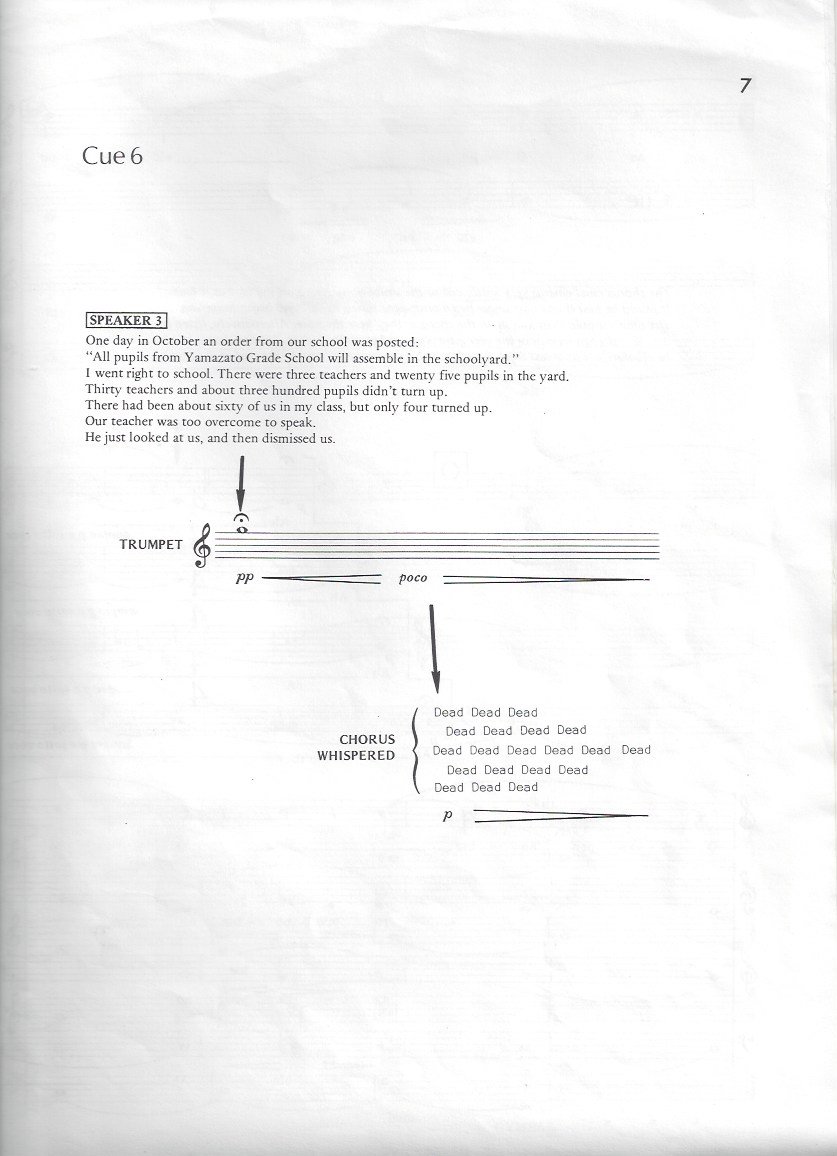Some words on the text Threnody
Elizabeth University of Music
The text for Threnody is based on Dr. Takashi Nagai’s record of the words of the children of Nagasaki. While R. Murray Schafer is unsure of the precise date he first encountered Dr. Nagai’s work, it occurred during a period of study in England. Needless to say Dr. Takashi’s book made a lasting impression on the composer. Dr. Nagai was born in Japan in the prefecture of Shimane. He majored in radiology at Nagasaki Medical University. At this time many tuberculosis patients lacked medical instruments for proper treatment, and those who received excessive doses of radiation were given life expectancy of three years due to “chronic bone marrow leukemia”.
Two months after the atomic bomb Dr. Nagai suffered the loss of his wife with serious injuries. After determined attempts to help with relief activities to save the wounded he was eventually bedridden. But due to his strong dedication to his research along with his deep spiritual faith, he was able to write ten books. He called his living quarters which consisted of merely two tatami mats ( about 4 square meters) “nyokodou” which came from the proverb “ have love for your neighbour as for yourself. Mark 12:31”.
At Nagai Memorial Museum the following words from Dr. Nagai’s ‘the Tower of Peace” are written:
“With the loss of my wife, my house and property, my livelihood and my health I have only my brain, my vision and a hand to write with. Up to now the frequent visits by many loving friends who have come to stand by me has given me reason to live. This is a suitable, quiet place, for a disabled man and his two young children”.
Dr. Nagai’s work “We of Nagasaki” grew out of these experiences recounted above. The book was published in 1952 by Chuo Shuppan. In the same year it was also published in German and English. This book, from which the text of Threnody is derived, consists of Dr. Nagai’s own words and the testimony of his two sons, Makoto and Kayano. Makoto’s testimony includes a story about his elementary school (Yamazato) near the blast site. Of the 1600 students attending the school only 300 survived. Many of the survivors became orphans and suffered severe burns (keloid) and verbal abuse being called “Genshi” (bomb victims) by their schoolmates. But they were nonetheless thankful to be alive. Dr. Nagai had his children recount their experience of the atomic bombing and published their testimony in the book “Living beneath the Atomic Cloud”. The proceeds from the sale of the work were divided among the children. In order to pass on the message of the importance of peace and the wretchedness of war to future generations of students, Dr. Nagai and his children discussed the idea of constructing a memorial for the children who had died. The children agreed, and with the help of their father to make up for any shortage of money the tombstones were completed and unveiled on November 3, 1949. Since then, the students and teachers of Yamazato elementary school have held a memorial service in front of the tombstones in which they sing “And Ko” (“That Child”).
“More that the loss of our houses and property, more than the loss of loved ones, even more than becoming disabled and unable to move due to sickness, of all the injuries as victims of the atomic bomb, it was the loss of faith in humanity which resulted from seeing so vividly the defiling of the spirit. While the horror and sadness of the destruction and loss of life gradually fades with the passing of time, what I find most tormenting is this clear realization of the loss of spirit”.
Yuki Umesaki
Teacher, Iwaya Junior High School, Nagasaki
Alumna of Elisabeth of Music, Hiroshima
The objective of the Threnody Peace Education Project stems from nothing less than the longing for peace for all people living in the 21st century. I would like to sincerely thank the young Canadian performers for bringing to fruition a realization of this work in Hiroshima 40 years after its premiere in Canada.
The memory of the war is gradually receding into the past. There are many cities throughout the world which also experienced the sadness of war just as we did on our country with the Tokyo air raids, and the battle of Okinawa. As the first victims of nuclear war, the people of Hiroshima and Nagasaki cannot forget this history. These people who experienced the bombing were not singled out, but were just ordinary people going about their daily lives. The victims of Hiroshima and Nagasaki strived to pass on the memory of this event to the younger generation. It is generally assumed that the greatest incentive to pass this message on came from those living in Hiroshima , Nagasaki and the rest of Japan. However, it was through the performance of Threnody, in a country as far away as Canada, by students and teachers involved in ensuring that the memory of the horror of war should not wear thin over time that this message was passed on. The victims of Nagasaki and Hiroshima, while not expressing their feelings directly, certainly felt and feel the same way. However it is a little unusual that this message was passed on through the performance of a composition written for children by a Canadian composer 40 years ago.
Schafer conceived this composition as an educational work in which children performers are actively involved in the process of joining together to experience, consider and even create the music. More than a simple introduction to contemporary music, through the activities described above, this work is intended to develop the child’s thinking about peace. According to the composer, Threnody is not a conventional concert work. So what is the reason for performing the work? First, the impact on the performers is of importance. In fact, speaking of the Canadian performance, the children’s parents were concerned that the content of the composition was too extreme. Carl Goulding defended the work and responded to these concerns to them parents saying “it is our job as teachers to ensure that the memories of the war do not fade over time”. Goulding’s words echo the concerns of the students and teachers in Nagasaki and Hiroshima who feel that the difficulty of peace education music be confronted.
When teachers involved in education speak of peace, it is their desire to pass on to the next generation of young people a sense of dignity and joy of being alive. The text of this work is based on the testimony of the children in Nagasaki who were victims of the atomic bomb attack. This text is very familiar to the children of Nagasaki who studied it as part of their education in world peace. In Schafer’s work, while the text is presented in a different form, the children can certainly glean its meaning in this new context. While music education is not the same as peace education there is certainly much that we teachers in Japan can learn from the musical activity in a country as far away as Canada. Scahfer’s conception of “active participation, experiencing and creating” gives us in Japan a strong model for peace education. We are happy to have the opportunity to learn from the realization of this project.
Having reached the 60th anniversary of the atomic bombing of Hiroshima and Nagasaki we are very pleased to witness the performance of this work made possible through the efforts of R. Murray Schafer, Carl Goulding and all the Canadian performers who are participating in this event. Through their search for a new form of music making in the performance of Threnody, Schafer and Goulding have offered us teachers a model for peace education studies in Japan.
This model of peace education does not stop after acknowledging the damage and sorrow of war, but rather encourages hope and solidarity between all those involved in peace education to educate the children of the world regardless of their nationalities and cultural differences.
From the Students
“Every year on August 6, to commemorate those who died, people float colourful paper lanterns of all shapes and sizes down the Motoyasa River near the A-Bomb Dome. It is the same river that swallowed up thousands of victims’ bodies that fateful day in 1945. How can we forget what happened that day when so many men, women and children and animals perished and thousands suffered horrific, lingering injuries?........It is the duty of everyone alive today to ensure that what happened in Hiroshima on that fateful day is not forgotten and is never repeated.”





